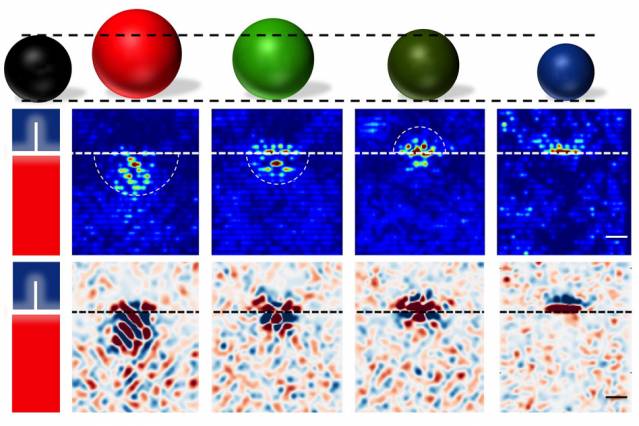Mar 6 2015
MIT researchers have discovered that dislocations in oxides e.g., cerium dioxide, exhibit a property contrary to what was previously known.
 Simulations show the effects of dislocations in cerium dioxide on the redistribution of differently sized dopant atoms, replacing a cerium atom in the crystal lattice. The results reveal different amounts of segregation around the dislocation caused by the differently sized elements. The sizes of the other atoms are compared to a cesium atom (left, in black). The white dashed line shows the plane of the dislocation caused by strain. (Image courtesy of the MIT researchers)
Simulations show the effects of dislocations in cerium dioxide on the redistribution of differently sized dopant atoms, replacing a cerium atom in the crystal lattice. The results reveal different amounts of segregation around the dislocation caused by the differently sized elements. The sizes of the other atoms are compared to a cesium atom (left, in black). The white dashed line shows the plane of the dislocation caused by strain. (Image courtesy of the MIT researchers)
Formerly, researchers thought that a certain kind of strain such as the strain caused by dislocations in the atomic lattice of a material aided in speeding the movement of oxygen ions via the material, thereby possibly leading to rapid diffusion, which is essential in high-performance solid oxide fuel cells, oxygen-separation membranes, or water-splitting.
However, simulating oxide ion transport at the atomic-level has shown that while these dislocations greatly speed up atom movement in metals, they tend to display a contrary effect in this metal-oxide material, and perhaps in several other materials.
Instead of easing ion mobility, it turns out that dislocations in cerium dioxide cause a kind of “traffic jam” for the flowing ions, slowing them to a crawl, says MIT graduate student Lixin Sun, lead author of a paper describing the analysis in the journal Nature Communications.
In cerium dioxide, which is already used as an electrolyte material in solid oxide fuel cells, the simulation shows that “edge dislocations slow down oxide ion diffusion, contrary to the well-known fast diffusion of atoms along dislocations in metals,” says Bilge Yildiz, an associate professor of nuclear science and engineering and of materials science and engineering, who was the paper’s senior author.
The surprising outcome indicates that researchers will have to continue pursuing various approaches in trying to accelerate the transport of these ions.
The MIT research analysis is part of an ongoing project on how different kinds of strain in thin-film materials can be applied to modify and enhance the movement and surface reaction kinetics of these materials, with dramatic results. It was conducted by Yildiz and her team, which also includes co-author and research scientist Dario Marrocchelli,
“People have argued about the role of strain [in cerium dioxide],” Sun says. “Some say strain can enhance the oxide ion transport for devices like solid oxide fuel cells. But others say no, and the experimental results show orders-of-magnitude scatter.”
While currently there is a considerable amount of research on ion movement under elastic strain — for instance when a rubber band is elongated, it returns to its usual length when released — the same does not occur in the case of transport along dislocations arising from plastic strain in oxides.
Plastic strain — for instance when a piece of taffy is stretched, it remains in that state introducing a considerable amount of defects termed as dislocations into crystalline structures; the speeding effect that dislocations have on atom movement in metals has been extensively studied.
“But in oxides, which are important in energy-conversion devices such as fuel cells, electrolyzers, and batteries, the dislocation effects remains largely understudied,” she adds. “It’s never been studied at the atomic level to reveal what an individual dislocation does to oxide ion transport, and that’s why we turned our attention to it.”
Because that kind of strain has been more difficult to simulate and measure, Sun says, “People speculated that it could enhance ionic transport,” since that’s what happens with metals. While the new conclusions were based on a detailed analysis of the molecular structure of cerium dioxide, Sun says the results “should be general to those materials that have a high concentration of defects” — which include many, but not all, metal oxides.
Particularly, the conclusions revealed that dislocations hold a large amount of oxygen vacancies and dopant metal cations, and because of which these ionic defects interact and trap each other, “like too many cars clogging a highway”, Sun says.
The MIT research was supported by the U.S. Department of Energy and the National Science Foundation.